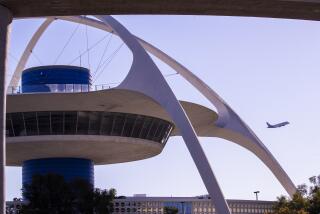New Suburban Airport Rules Aimed at Cutting Rate of Near-Collisions
- Share via
Seeking to reduce a record number of near-collisions in the skies above suburban airports, the Federal Aviation Administration is launching a new traffic control program that will require pilots as far as 10 miles away to contact air traffic controllers and announce their whereabouts.
The new regulations, scheduled to take effect at three Southern California airports on Jan. 16, are the culmination of a four-year review of the national airspace system that is expected to reduce delays and increase safety at 66 of the nation’s busiest mid-sized airports.
Ontario, Burbank and El Toro Marine Corps Air Station were designated as the first California airports subject to the new controls in final FAA regulations issued Friday. The El Toro airport essentially will cover most of the air space around John Wayne Airport in Orange County.
Larger Airports Covered
While most major air terminals such as those in Los Angeles, New York, Chicago, San Diego and San Francisco already have stringent controls on planes operating nearby, the new program addresses a growing problem at suburban airports, where large numbers of private aircraft must blend with commercial jet traffic, creating the potential for accidents.
While existing regulations require pilots to contact an airport’s control tower when they come within five miles of the airport, there has been no mechanism to require anything other than voluntary communication in areas that may be just as congested farther from the airport, FAA officials said.
The problem has been brought into focus by several collisions and many near-collisions recently. The 589 incidents last year in which two aircraft came dangerously close to each other set a new record, and reported near-collisions this year are up 33% from the same period in 1984, federal officials said.
Need for Action
“We just feel that we have to do everything in our power to provide for a safe environment within the navigable airspace. The entire program is a safety program,” said Joseph Fowler, airspace specialist for the FAA’s Los Angeles region.
The new regulations, which eventually will establish control zones known as “airport radar service areas” around 66 major airports, are also expected to reduce air traffic delays because they reduce the distance controllers are required to maintain between aircraft within the zones.
Small aircraft owners and pilots already are mounting a challenge to the new program, which they say unnecessarily restricts their ability to fly where they want to. They say the current regulation is adequate and new regulations could actually increase safety hazards by encouraging pilots to fly too low or too near mountainous terrain to avoid the new control zones.
4,000-Foot Upper Limit
The control zones would extend up to 4,000 feet within a 10-mile radius of each airport, but would be limited to a five-mile radius below 1,200 feet.
But the Airline Pilots Assn. said the program is “a positive step to decrease the potential of a midair collision in the busy terminal areas where the risk of a collision is at its peak.”
“There are certain airports in this country where the traffic conditions are such that we need to exercise a little bit more control in order to protect the traveling public,” said John O’Brien, director of engineering and air safety for the airline pilots group. “There are only certain ways we can provide that protection, and this is one of them.”
Patricia Weil, spokeswoman for the 265,000-member Aircraft Owners and Pilots Assn., said more air traffic controllers were needed to handle the new program at three airports where it has been started--Columbus, Ohio, Austin, Tex., and Baltimore, Md.
Particularly in Baltimore, she said, many pilots have experienced delays in getting permission to fly into the region, and some pilots have simply been denied access to the control zone because of heavy controller workloads.
Too Much Traffic
“Obviously, they’re not going to be able to handle all the traffic that is going to be coming their way,” she said. “And because of those problems, a lot of people will obviously elect not to fly in the ARSA (airport radar service area). . . . At various locations around the country, flying under the ARSA will mean bringing airplanes closer to populated areas than a prudent pilot might like.”
Paul Smith, spokesman for the FAA’s airspace rules division in Washington, acknowledged that there were delays for some light aircraft pilots in Baltimore earlier this year, but he said increases in air traffic were the primary reason.
Noise is another issue that has emerged in the control zone debate. Burbank-Glendale-Pasadena Airport managers, for example, said they believe the new regulations will enhance safety but could mean that aircraft will begin flying over outlying residential areas to avoid the new zone.
Eleven More Scheduled
Eleven airports on the East Coast, Texas and Oklahoma are scheduled for the new control zones on Dec. 19. The three Southern California airports are part of a block of 22 airports throughout the nation coming under the regulations in mid-January.
By April of next year, airports at Sacramento, several surrounding military bases, Oakland and Castle Air Force Base near Merced will also become part of the program.
The control zone at Burbank-Glendale-Pasadena will include private aircraft from nearby Van Nuys Airport--one of the busiest airports in the nation--and control zones at Ontario and nearby March and Norton Air Force bases will include most traffic operating within the entire Riverside County basin.
More to Read
Inside the business of entertainment
The Wide Shot brings you news, analysis and insights on everything from streaming wars to production — and what it all means for the future.
You may occasionally receive promotional content from the Los Angeles Times.










